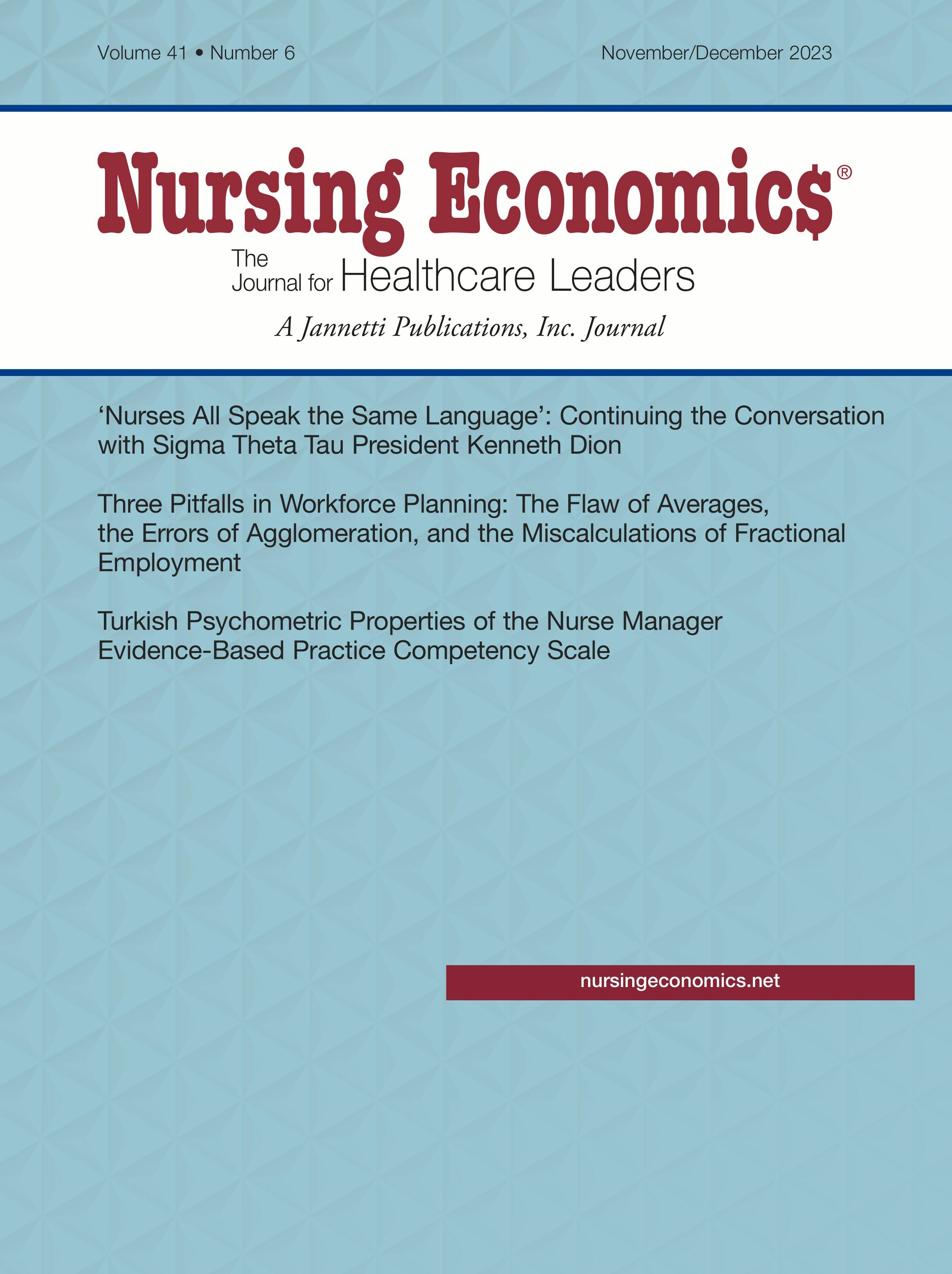Nursing Economic$ Journal
|
The Perspectives in Ambulatory Care Nursing column is authored by members of the American Association of Ambulatory Care Nurses. The column captures the essence and makes sense of today's rapidly changing ambulatory care market. The AAACN Board puts forth timely topics that reflect the work of the organizations and identifies authors to disseminate strategic priorities and initiatives of AAACN to a broader audience of clinical leaders in multiple practice settings. AAACN members who are interested in publishing should reach out to the column editor: Heather Ryan, PhD, RN, CPN at nejrnl@ajj.com. The Perspectives in Ambulatory Care column follows the author guidelines of Nursing Economic$ The Journal for Healthcare Leaders. |
 |
 Heather Ryan PhD, RN, CPN |
Author Guidelines
Writing for Nursing Economic$
The journal’s purpose is to advance nursing leadership in health care, with a focus on tomorrow, by providing information and thoughtful analyses of content and emerging best practices in health care management, economics, and policy making. Query letters are welcome, but not required. Material must be original and previously unpublished. Material is submitted for review with the understanding that it is not being simultaneously submitted to any other journal.
Nursing Economic$ is a refereed journal. All manuscripts submitted undergo review by the editor and blind review by members of the manuscript review panel and/or editorial board. Each manuscript is reviewed on its timeliness, importance, clarity, accuracy, and applicability. Upon acceptance of the manuscript, the author will yield copyright to Nursing Economic$. Acquiring permission to reprint previously published materials (figures, tables, photos, etc.) is the responsibility of the author. Authors have the responsibility to verify that they have read all the materials cited in their manuscript and, if necessary, have contacted the relevant authors to verify the accuracy of the cited material. Manuscripts are subject to copy editing. The author will receive proofs via email for review prior to publication.
Manuscript Preparation
Manuscripts must be typewritten, double-spaced, on an 8.5 x 11-inch document; maximum length is 15 pages (3,750 words). References, photographs, tables, and all other details of style must conform to the Publication Manual of the American Psychological Association (APA 7th ed., 2019).
- Title Page: Include the manuscript title, authors’ names, credentials, and a brief biographic statement. Also include an address for correspondence, email address (required), day and evening phone numbers, and a brief abstract of 40 words or less.
- Text: Double-space all text, using 1 to 2-inch margins. The manuscript title should be repeated on the first page of the text, but do not include the author’s name. Subheadings: Include subheadings in the manuscript where possible. Type all subheadings flush to the left margin.
- References: References, photographs, tables, and all other details of style must conform with the Publication Manual of the American Psychological Association. All references in the text should be cited by author and date, for example, (Doe & Brown, 2018) with page numbers cited for direct quotations. List all references in alphabetical order. Only use references that are actually cited within the text. Authors are encouraged to provide the digital object identifier (DOI) number directly after all references when possible.
- Citing multiple authors: In-text citations with three or more authors should include the first author followed by et al., even in the first citation. In the References list, if there are eight authors or more, list the first six, then an ellipsis, then the last author. If there are seven authors, list all seven. Sample references are shown below:
- Periodical (eight authors or more): Doe, J.R., Brown, M.S., Smith, J.R., Jones, M.S., Thomas, J.R., White, M.S., ... James, J.R. (2018). Coping with hospitalization. Nursing Economic$, 21(2), 115-120.
- Book (seven authors): Doe, J.R., Brown, M.S., Trent, J.R., Michaels, M.S., Bradley, J.R., Willis, R.Y., & Williams, J.R. (2018). The cost of nursing care. Academic Press.
- Chapter in a Book: Doe, J.R. (2018). Writing for publication. In M.S. Brown (Ed.), How to write for a medical journal (5th ed.) (pp. 79-86). Elsevier.
- Website: Doe, J.R., & Brown, M.S. (2018). Writing for publication. writingforpublication.com. Note: Manuscripts must NOT contain reference software codes, and the use of reference software is highly discourage.
- Figures: These include line drawings, diagrams, and graphs. Each figure should be numbered. When using figures adapted from another source, the author must obtain written permission for both print and electronic use from the original publisher. All figures should be submitted camera-ready.
- Photographs: Photographs may be digital or hard copy prints. Digital photographs must be of a resolution of at least 300 dpi or a minimum of 1280 x 960 pixels. Hard copy prints must be 4" x 5" or larger, of good contrast, and printed on glossy paper.
- General: All graphics, figures, and forms must be submitted camera-ready.
Nursing Economic$ Perspectives in Ambulatory Care Nursing
To access these articles for free, log into your AAACN account and search the online library.
2024
2024
Mobilizing Excellence for Patients and Nurses in the Ambulatory Care Environment: Describing the ANCC Pathway Program and AAACN Resources
Sept/Oct
Christine Pabico, Linda Harden, Rachel Start
Operationalizing Social Determinants of Health Assessments to Tackle Food Insecurity
Nov/Dec
Edtrina Moss, Kristen Shear
Understanding the Landscape of Ambulatory Care Nursing: Development of a Scoping Review
May/June
Jessica Varghese, Kristen Shear
Distinctions in Workplace Violence in Ambulatory Care
March/April
Dawn Fletcher, Elizabeth Sparks
How the Magnet Model Promotes Excellence in Ambulatory Care Nursing
January/February
Rachel Start, Elizabeth Carreira, Rebecca Graystone
2022-2023
2023
American Academy of Ambulatory Care Nursing Position Paper: The Role of the Registered Nurse in Ambulatory Care
November/December
Aleesa M. Mobley, Jean M. Bernhardt, Deborah Cantlin, Calli Wood, Tera Bartlet, Anne T. Jessie, Amanda Huff, Cynthia Painter Press
Registered Nurse Billing in Primary Care
July/August
Stephanie G. Witwer, Angela Mattson, Anne T. Jessie
Potential Clinical and Economic Impact of Registered Nurses Supporting Opioid Use Disorder Treatment in the Ambulatory Care Setting
May/June
Mary Blankson
Catalyzing Transformation and Ambulatory Care Nurse Action for the Future of Nursing
Jan/Feb
Kathy Mertens, Kristene Grayem, Kathleen Martinez, Kelly Mattar, Jenelle Zambrano, Storm Morgan, Natalie Bycenski, Laurie Graaff, Mary Myers, and Adrian Jonas
Gaining Insight into Member Demographics and Perceptions of Diversity, Equity, and Inclusion Initiatives in a Professional Organization (AAACN)
March/April
Kim Regis, Quyen Phan, Amy Cadoret, Nancy Parker, and Beth Ann Swan
2022
Changing Landscapes: Academic-Practice Partnerships in Evolving Ambulatory Care Settings – Part 1
March/April 2022
Vanessa M. DeBiase, Caroline Coburn, Laurel More, Linda Parsons
In Search of the Evidence: Informing Academic-Practice Partnerships in Ambulatory Care
May/June 2022
Stephanie G. Witwer, Elizabeth Fritz, Susan M. Antol, Stephanie Bilskis
Developing the American Academy of Ambulatory Care Nursing Academic Practice Guidelines: Academic Practice Partnership in Action
July/August 2022
Mary DiGiulio, Diana Alemar, Annette S. Hamlin, L. Jessie Jones-Bell, Laurel More
2020-2021
2021
Using Nurse-Sensitive Indicators to Assess the Impact of Primary Care RNs on Quality Ambulatory Patient Care
July/August 2021
Rebecca Alley, Elizabeth Carreira, Cynthia Wilson, Katelin Pickard
Assessing the Knowledge and Attitudes of Registered Nurses about Artificial Intelligence in Nursing and Health Care
May/June 2021
Beth Ann Swan
Advancing the Science of Nursing: Ambulatory Care Nursing and Magnet® Designation
March/April 2021
Rachel Start, Rebecca Graystone
Return on Investment of a Centralized Telephonic Case Management Program in a Commercial Population
January/February 2021
Sara Russell Rodriguez, Steve Pirlot
2020
Creating a Business Case Template for Care Coordination and Transition Management
Nov/Dec 2020
Diane Storer Brown, Rachel Start, Ann Marie Matlock
Using Innovative Education to Elevate Unlicensed Assistive Personnel Practice
Mar/Apr 2020
Laurel More, Linda Parsons
Strategies for Creating a Business Case that Leverages the RN Role in Care Coordination and Transition Management
July/August 2020
Rachel Start, Sharon Quinlan, Sara Russell Rodriguez, Diane Storer Brown, Mary Blankson, Ann Marie Matlock, Nancy May
2018-2019
2019
The American Academy of Ambulatory Care Nursing's Invitational Summit on CCTM: An Overview
Jan/Feb 2019
Sheila Haas, Beth Ann Swan
Care Coordination: Roles of Registered Nurses Across the Care Continuum
Nov/Dec 2019
Beth Ann Swan, Sheila Haas, Anne T. Jessie
2018
Transition to Practice-Part 3: Implementing an Ambulatory Care Registered Nurse Residency Program: RN Residency and Transition to Professional Practice Programs in Ambulatory Care-Challenges, Successes, and Recommendations
Jan/Feb 2018
L. Jessie Jones-Bell, Cathryn Halford-Cook, Nancy Weaver Parker
Opportunities for Nurses to Lead Quality Efforts Under MACRA
March/April 2018
Yumi Ma, Nancy May, Courtney Knotts, Annette DeVito Dabbs
Implementation and Evaluation of an Ambulatory Care Nurse Clinical Advancement System
May/June 2018
Susan M. Hossli, Rachel Start, Marcia P. Murphy
Realizing Momentum and Synergy: Benchmarking Meaningful Ambulatory Care Nurse-Sensitive Indicators
Sept/Oct 2018
Rachel Start, Ann Marie Matlock, Diane Brown, Harriet Aronow, Lynn Soban
Evolution of a Conceptual Model: Ambulatory Care Nursing
Nov/Dec 2018
Margaret Mastal
2016-2017
2017
American Academy of Ambulatory Care Nursing Position Paper: The Role of the Registered Nurse in Ambulatory Care
Jan/Feb 2017
American Academy of Ambulatory Care Nursing
Leveraging National Reports to Transform Ambulatory Care Practice
March/April 2017
Anne T. Jessie, Beth Ann Swan
Registered Nurses Make a Difference with Ambulatory Care Nurse-Sensitive Indicators
July/August 2017
Rosemarie Battaglia, Mary Morin, Dana Nelson, Rachel E. Start, Beverly Sullivan
Transition to Practice-Part 1: Implementing the AAACN Ambulatory Care Nurse Residency Program: The Importance of a Structural Framework
Sept/Oct 2017
June Levine
Transition to Practice-Part 2: Implementing an Ambulatory Care Registered Nurse Residency Program: Competency-It's Not Just a Task
Nov/Dec 2017
Laurel More
2016
Ambulatory Care Nurse-Sensitive Indicator Series: Capturing the Role of Nursing in Ambulatory Care-The Case for Meaningful Nurse-Sensitive Measurement
March/April 2016
Margaret Mastal, Ann Marie Matlock, Rachel Start
Ambulatory Care Nursing-Sensitive Indicators Series: Reaching for the Tipping Point in Measuring Nurse-Sensitive Quality in the Ambulatory Surgical and Procedure Environments
May/June 2016
Diane Storer Brown, Harriet Udin Aronow
Ambulatory Care Nurse-Sensitive Indicators Series: Starting with Low-Hanging Fruit: Proposing the Adaptation of Health Care Measures to the Role of the Nurse in Ambulatory Care
July/August 2016
Rosemarie Battaglia, Rachel Start, Mary Morin
Ambulatory Care Nurse-Sensitive Indicators Series: Patient Engagement as a Nurse-Sensitive Indicator in Ambulatory Care
Nov/Dec 2016
Eileen M. Esposito, Catherine A. Rhodes, Catherine M. Besthoff, Nena Bonuel
2014-2015
2015
Nursing-Sensitive Indicators in Ambulatory Care
Jan/Feb 2015
Kathleen Martinez, Rosemarie Battaglia, Rachel Start, Margaret F. Mastal, Ann Marie Matlock
Health Care in the Community: Developing Academic/Practice Partnerships for Care Coordination and Managing Transitions
May/Jun 2015
Mary E. Fortier, Donna M. Fountain, Maryelena Vargas, Lisa Heelan-Fancher, Tracy Perron, Katherine Hinic, Beth Ann Swan
2014
Developing the Value Proposition for the Role of the Registered Nurse in Care Coordination and Transition Management in Ambulatory Care Settings
Mar/Apr 2014
Sheila Haas, Beth Ann Swan
2012-2013
2013
Developing Ambulatory Care Registered Nurse Competencies for Care Coordination and Transition Management
Jan/Feb 2013
Sheila Haas, Beth Ann Swan, Traci Haynes
2012
Building a Clinical Ladder for Ambulatory Care
Jan/Feb 2012
Colleen Woolsey, Kate Bracy
Models of Care in Outpatient Cancer Centers
Mar/Apr 2012
Charlotte T. Lee, Barbara Fitzgerald, Sarah Downey, Malcolm Moore
The Value of Registered Nurses in Ambulatory Care Settings: A Survey
Sep/Oct 2012
Margaret Mastal, June Levine
2010-2011
2011
American Academy of Ambulatory Care Nursing Position Statement: The Role of the Registered Nurse in Ambulatory Care
Mar/Apr 2011
American Academy of Ambulatory Care Nursing
The Effectiveness of Reminder Phone Calls on Reducing No-Show Rates in Ambulatory Care
Sep/Oct 2011
Rebecca Woods
Health Care Reform: Current Updates and Future Initiatives For Ambulatory Care Nursing
Nov/Dec 2011
Beth Ann Swan, Sheila A. Haas
2010
Evolution of the Chronic Care Role of the Registered Nurse In Primary Care
Nov/Dec 2010
Candia Baker, Laughlin Marie Beisel
Ambulatory Care Registered Nurse Performance Measurement
Sep/Oct 2010
Beth Ann Swan
Ambulatory Care Nursing: Growth as a Professional Specialty
Jul/Aug 2010
Margaret Fisk Mastal
